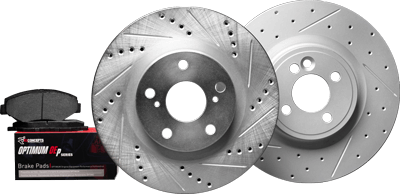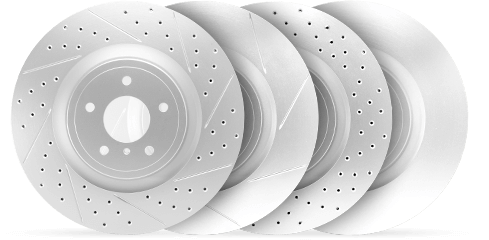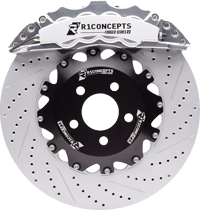Struggling with brake pad wear? This article cuts through the noise to reveal the main culprits of worn brake pads, how to spot the signs of wear, and essential tips for extending the life of your vehicle’s brakes. We’ll unpack important factors such as friction, heat, and material choices that impact brake pad longevity, equipping you with the knowledge to drive safely and maintain your braking system effectively.
Key Takeaways
- Brake pad wear is a natural result of friction and heat generated during braking, with contributing factors including material composition, contamination, corrosion, and improper installation leading to variable wear rates and potential safety concerns.
- Abnormal brake pad wear patterns such as inner pad wear, outer pad wear, glazed/cracked/lifted edges, and tapered pads can diagnose issues with caliper mechanics, misalignment, and heat dissipation, necessitating proper inspection and maintenance.
- Regular vehicle maintenance, choosing suitable brake pad materials, adhering to responsible driving habits, and correct installation are crucial for prolonging brake pad life, ensuring safety, and maintaining optimal braking performance.
Understanding Brake Pad Wear and Its Implications
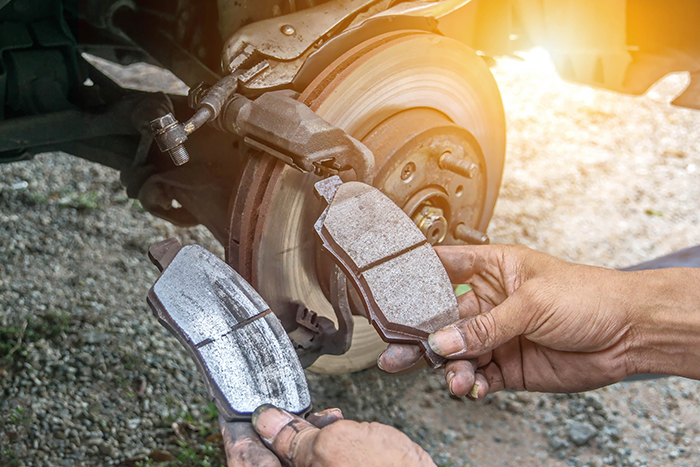
The wearing down of brake pads is an inevitable process caused by the interaction and friction between the pads and rotors each time a vehicle’s brakes are applied. This consistent usage gradually diminishes the thickness of the brake pads, with every pad having a specified minimum thickness level. When they wear down past this safety threshold, their continued use becomes hazardous.
Excessive wear on your vehicle’s brake pads can lead to compromised braking efficacy, potentially leading to longer stopping distances and heightened accident risk. It’s crucial to understand what contributes to rapid pad wear in order to minimize it effectively.
We’re going to delve into several key contributors that accelerate the deterioration of brake pad material.
The Role of Friction in Brake Pad Wear
When the brake pedal is depressed, it forces the brake pads to clamp down on the rotors, creating friction that helps decelerate or halt your vehicle. This interaction between pads and rotors plays a crucial role in how much wear occurs on your braking components.
Braking involves two main forms of friction: abrasive and adherent. Abrasive friction results in both pad and rotor degradation as their surfaces gradually erode away while adherent friction happens when material from the brake pad deposits itself onto the rotor’s surface. Consequently, these different types of frictions lead to varying degrees of physical and chemical alterations which contribute to wear on both brake pads and rotors.
Heat’s Impact on Your Brake Pads
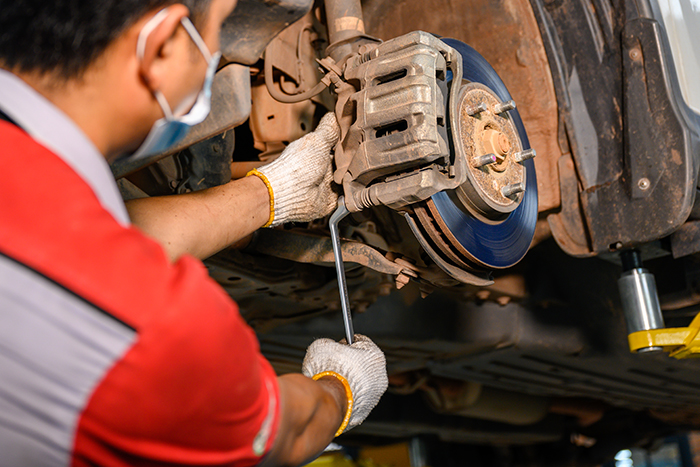
The generation of too much heat has a big effect on how quickly brake pads wear out. If you drive very fast, carry heavy things, or go down steep hills, this can make a lot of heat, which makes your brake pads wear out faster.
Driving in a way that makes the car work hard can make a lot of heat, and this makes the brake pads thin out quicker. If you carry heavy stuff or drive down steep roads, this also makes more heat and puts extra stress on the brakes. To make your brake pads last longer, it’s good to drive carefully and not carry too much weight in your car.
Brake Pad Contamination
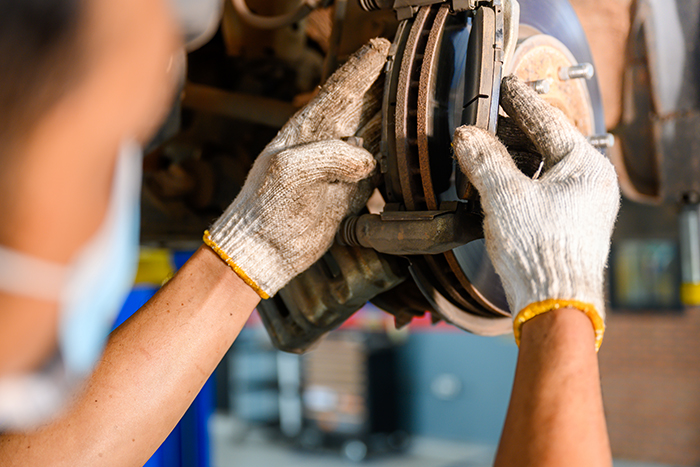
The presence of dirt, oil, or water on the brake pads can cause them to wear out unevenly. These substances interfere with the necessary friction between the pads and the rotor, often leading to noisy brakes and less effective stopping power.
To protect your brake system from these harmful contaminants, it’s important to keep it clean. You should avoid handling the brake pads with bare hands and regularly check your vehicle’s brake system as part of your normal car care routine. Doing so will help maintain even wear on the pads and ensure that your brakes work properly.
Corrosion
Corrosion is another factor that can cause brake pads to wear out. Both brake pads and rotors are made of materials like steel and cast iron, which can rust when they get wet. This rust can happen when they are exposed to rain, dew, snow, and humidity.
Usually, using your car’s brakes regularly will clean off any light rust on the pads and rotors. However, if a car is not used for a long time, rust can build up and weaken the rotors. Rust on the backing plate of the pad can also lead to:
- The breaking apart of the pad material
- More noise when braking
- Shaking or vibration
- A rough feeling when you use the brakes
To keep your brakes from getting rusty, it’s a good idea to use high-quality brake parts that resist rust. Also, try to park in dry areas and wash your car regularly to get rid of salt from the roads. These steps are important to keep your brakes working well.
If you don’t drive your car for a long time, the rotors can get a more serious kind of rust called pitting. This can affect how well your brakes work. If this happens, you might need to replace the damaged rotors.
Brake Pad Material
The type of material used to make brake pads is very important because it affects how quickly they wear out. There are different kinds of materials for making brake pads, and each has its own advantages and disadvantages.
For instance, brake pads made from organic materials are usually quieter when you use them, but they may not last as long. On the other hand, brake pads that contain metal last longer but they might make more noise when you brake. It’s important to choose the right kind of brake pad material based on how you use your car to make sure your brake pads last as long as possible.
The Problem with Installing Brake Pads Incorrectly
If brake pads are not put in the right way, they can press unevenly against the rotors, which causes them to wear out faster and unevenly. Using the wrong type of pads for your car’s rotors or discs can also make your brakes less effective and cause the brake pads to wear out more quickly. To prevent your brake pads from wearing out too soon because of wrong installation, it’s important to check them often and take good care of all the parts in your braking system.
Making sure that your new brake pads are put in correctly is very important to avoid problems with your brakes later on.
Types of Brake Pad Wear Patterns
Recognizing various patterns of brake pad wear is crucial for pinpointing distinct problems in the brake system. Normal usage is reflected by even wear across the pads, but if there’s uneven or slanted wear, it might point to complications within the braking mechanism or how one drives.
Particular issues such as misalignment or a defect in the brake apparatus can be revealed through atypical patterns of pad deterioration. Signs that your brake pads may be worn include diverse forms like:
- Wear predominantly on the inner side of the pad
- Wear mostly on outer portion of pads
- Pads exhibiting tapered erosion
- Brake pads showing signs like cracks, glossiness, or edges starting to separate
In subsequent segments below, we’ll delve into these specific types of wear down experienced by brake pads and explain what each could potentially signify about your vehicle’s brakes along with possible corrective actions.
Inner Pad Wear
Uneven wear of the inner brake pads often signifies trouble with the brake caliper or piston. For example, a misaligned vehicle might cause one-sided wear on these pads. Slide pins that are corroded or blocked can impede the proper motion of the caliper, leading to excessive wear on the inner pad. If debris or rust causes caliper pistons to stick, it may force brake pads against the rotor more intensely, accelerating their deterioration. If there’s unevenness in rotor thickness or any defects preventing uniform pressure during braking could result in disproportionate wear down of inner brake pad surfaces.
Outer Pad Wear
This is the inverse of the inner pad wear. Outer pad wear can be caused by the outer pad continuing to ride on the rotor even after the caliper has been released, when the caliper guide pins and bushings are seized, or when the pads get seized inside the slides.
This problem can be addressed by servicing or replacing the caliper guide pins and bushings, lubricating the caliper slides, and inspecting the caliper for damaged guide pinholes. Replace the brake pads in order to complete the repairs.
Glazed, Cracked Or Lifted Edges
Excessive heat or malfunctions in the caliper can lead to glazing, cracking, or edges that appear lifted on brake pads. These signs of abnormal wear on the brake pad are often noticeable upon visual inspection.
When it comes to the friction material on a brake pad, cracked linings or chipped corners may develop due to an excessive accumulation of heat or issues with the caliper not releasing correctly. Recognizing these patterns of pad wear is crucial for identifying and fixing problems in the brake system.
Tapered Pads
Another prevalent pattern of wear that suggests potential misalignment or disproportionate pressure distribution in the brake system is tapered pad wear. This type of wear might stem from complications with the brake caliper, for instance, if it’s not sliding as intended. To ensure optimal performance of the pads within your vehicle’s braking mechanism, examining the wear indicator on each pad is crucial.
When you notice a tapering effect on your pads’ surface, this could mean there’s an alignment problem between both brake calipers and pads themselves. Addressing issues related to tapered pad wear usually includes adjustments to align properly or securing unobstructed movement for the calipers.
Summary
In summary, it’s imperative to grasp the significance of brake pad wear for the upkeep of a vehicle’s safety and efficacy. Brake pad degradation is influenced by elements such as heat generation, frictional forces, exposure to contaminants, rusting processes, material composition of the pad itself, and errors in fitting. Recognizing distinct patterns in brake pad abrasion can aid in pinpointing particular malfunctions within the braking apparatus. Consistently monitoring and servicing your vehicle’s brake system is essential for maintaining peak functionality and ensuring secure operation.


